10.2: Qing Dynasty (1636 – 1911)
- Page ID
- 220012
\( \newcommand{\vecs}[1]{\overset { \scriptstyle \rightharpoonup} {\mathbf{#1}} } \)
\( \newcommand{\vecd}[1]{\overset{-\!-\!\rightharpoonup}{\vphantom{a}\smash {#1}}} \)
\( \newcommand{\id}{\mathrm{id}}\) \( \newcommand{\Span}{\mathrm{span}}\)
( \newcommand{\kernel}{\mathrm{null}\,}\) \( \newcommand{\range}{\mathrm{range}\,}\)
\( \newcommand{\RealPart}{\mathrm{Re}}\) \( \newcommand{\ImaginaryPart}{\mathrm{Im}}\)
\( \newcommand{\Argument}{\mathrm{Arg}}\) \( \newcommand{\norm}[1]{\| #1 \|}\)
\( \newcommand{\inner}[2]{\langle #1, #2 \rangle}\)
\( \newcommand{\Span}{\mathrm{span}}\)
\( \newcommand{\id}{\mathrm{id}}\)
\( \newcommand{\Span}{\mathrm{span}}\)
\( \newcommand{\kernel}{\mathrm{null}\,}\)
\( \newcommand{\range}{\mathrm{range}\,}\)
\( \newcommand{\RealPart}{\mathrm{Re}}\)
\( \newcommand{\ImaginaryPart}{\mathrm{Im}}\)
\( \newcommand{\Argument}{\mathrm{Arg}}\)
\( \newcommand{\norm}[1]{\| #1 \|}\)
\( \newcommand{\inner}[2]{\langle #1, #2 \rangle}\)
\( \newcommand{\Span}{\mathrm{span}}\) \( \newcommand{\AA}{\unicode[.8,0]{x212B}}\)
\( \newcommand{\vectorA}[1]{\vec{#1}} % arrow\)
\( \newcommand{\vectorAt}[1]{\vec{\text{#1}}} % arrow\)
\( \newcommand{\vectorB}[1]{\overset { \scriptstyle \rightharpoonup} {\mathbf{#1}} } \)
\( \newcommand{\vectorC}[1]{\textbf{#1}} \)
\( \newcommand{\vectorD}[1]{\overrightarrow{#1}} \)
\( \newcommand{\vectorDt}[1]{\overrightarrow{\text{#1}}} \)
\( \newcommand{\vectE}[1]{\overset{-\!-\!\rightharpoonup}{\vphantom{a}\smash{\mathbf {#1}}}} \)
\( \newcommand{\vecs}[1]{\overset { \scriptstyle \rightharpoonup} {\mathbf{#1}} } \)
\( \newcommand{\vecd}[1]{\overset{-\!-\!\rightharpoonup}{\vphantom{a}\smash {#1}}} \)
\(\newcommand{\avec}{\mathbf a}\) \(\newcommand{\bvec}{\mathbf b}\) \(\newcommand{\cvec}{\mathbf c}\) \(\newcommand{\dvec}{\mathbf d}\) \(\newcommand{\dtil}{\widetilde{\mathbf d}}\) \(\newcommand{\evec}{\mathbf e}\) \(\newcommand{\fvec}{\mathbf f}\) \(\newcommand{\nvec}{\mathbf n}\) \(\newcommand{\pvec}{\mathbf p}\) \(\newcommand{\qvec}{\mathbf q}\) \(\newcommand{\svec}{\mathbf s}\) \(\newcommand{\tvec}{\mathbf t}\) \(\newcommand{\uvec}{\mathbf u}\) \(\newcommand{\vvec}{\mathbf v}\) \(\newcommand{\wvec}{\mathbf w}\) \(\newcommand{\xvec}{\mathbf x}\) \(\newcommand{\yvec}{\mathbf y}\) \(\newcommand{\zvec}{\mathbf z}\) \(\newcommand{\rvec}{\mathbf r}\) \(\newcommand{\mvec}{\mathbf m}\) \(\newcommand{\zerovec}{\mathbf 0}\) \(\newcommand{\onevec}{\mathbf 1}\) \(\newcommand{\real}{\mathbb R}\) \(\newcommand{\twovec}[2]{\left[\begin{array}{r}#1 \\ #2 \end{array}\right]}\) \(\newcommand{\ctwovec}[2]{\left[\begin{array}{c}#1 \\ #2 \end{array}\right]}\) \(\newcommand{\threevec}[3]{\left[\begin{array}{r}#1 \\ #2 \\ #3 \end{array}\right]}\) \(\newcommand{\cthreevec}[3]{\left[\begin{array}{c}#1 \\ #2 \\ #3 \end{array}\right]}\) \(\newcommand{\fourvec}[4]{\left[\begin{array}{r}#1 \\ #2 \\ #3 \\ #4 \end{array}\right]}\) \(\newcommand{\cfourvec}[4]{\left[\begin{array}{c}#1 \\ #2 \\ #3 \\ #4 \end{array}\right]}\) \(\newcommand{\fivevec}[5]{\left[\begin{array}{r}#1 \\ #2 \\ #3 \\ #4 \\ #5 \\ \end{array}\right]}\) \(\newcommand{\cfivevec}[5]{\left[\begin{array}{c}#1 \\ #2 \\ #3 \\ #4 \\ #5 \\ \end{array}\right]}\) \(\newcommand{\mattwo}[4]{\left[\begin{array}{rr}#1 \amp #2 \\ #3 \amp #4 \\ \end{array}\right]}\) \(\newcommand{\laspan}[1]{\text{Span}\{#1\}}\) \(\newcommand{\bcal}{\cal B}\) \(\newcommand{\ccal}{\cal C}\) \(\newcommand{\scal}{\cal S}\) \(\newcommand{\wcal}{\cal W}\) \(\newcommand{\ecal}{\cal E}\) \(\newcommand{\coords}[2]{\left\{#1\right\}_{#2}}\) \(\newcommand{\gray}[1]{\color{gray}{#1}}\) \(\newcommand{\lgray}[1]{\color{lightgray}{#1}}\) \(\newcommand{\rank}{\operatorname{rank}}\) \(\newcommand{\row}{\text{Row}}\) \(\newcommand{\col}{\text{Col}}\) \(\renewcommand{\row}{\text{Row}}\) \(\newcommand{\nul}{\text{Nul}}\) \(\newcommand{\var}{\text{Var}}\) \(\newcommand{\corr}{\text{corr}}\) \(\newcommand{\len}[1]{\left|#1\right|}\) \(\newcommand{\bbar}{\overline{\bvec}}\) \(\newcommand{\bhat}{\widehat{\bvec}}\) \(\newcommand{\bperp}{\bvec^\perp}\) \(\newcommand{\xhat}{\widehat{\xvec}}\) \(\newcommand{\vhat}{\widehat{\vvec}}\) \(\newcommand{\uhat}{\widehat{\uvec}}\) \(\newcommand{\what}{\widehat{\wvec}}\) \(\newcommand{\Sighat}{\widehat{\Sigma}}\) \(\newcommand{\lt}{<}\) \(\newcommand{\gt}{>}\) \(\newcommand{\amp}{&}\) \(\definecolor{fillinmathshade}{gray}{0.9}\)Introduction
When the Manchus from the northern part of China (10.2.1) descended into the south, they overtook the Ming dynasty, starting the Qing dynasty with a set of rulers that endeared for almost three hundred years. Earlier, the Mongols continually tried to overtake the Han Chinese until the Manchu defeated the Mongols. In 1636, as the Manchu Khan controlled much of China, the Great Wall remained the barrier to stop the invasion before reaching Beijing and the ocean. The central gate in the wall at Shanhaiguan was constructed as the most important military position, located between the mountains and sea. The pass served as a primary transportation corridor from the sea routes into other parts of China, was heavily guarded, and stopped earlier armies.

In 1644, with the Manchu located outside the Great Wall, the Ming lost in the continual local rebellions. Instead of launching an attack against the rebels, the Ming general opened the gate and let the Manchu through it as they swept across the rest of China and conquered Beijing. They did not annihilate Beijing and slaughter the people, the usual practice; instead, the leaders surrendered. The new emperors started a prosperous period from 1661 to 1722, which was considered the Qing golden age. They instituted new rules to control external trade, the population grew, and literary achievements created classical Chinese literature. From 1661 to 1722 was considered the Qing golden age; new rules controlled external trade, the population grew, and literary achievements created some classical documents.
"The brilliant reigns of the Kangxi (r. 1662–1722) and Qianlong (r. 1736–95) emperors displayed a period when the Manchus embraced Chinese cultural traditions, and the court became a leading patron in the arts as China enjoyed an extended period of political stability and economic prosperity."[1] The map of the dynasty (x.x) from 1760 to 1820 reflects the area considered under the control of the government. The small areas of light green were disputed territories.
The Qing dynasty in the eighteenth century was immense and prosperous, and it embraced significant cultural and artistic achievements. During this period, the court expanded and supported traditional Chinese arts and customs. Three artists' styles grew from the court's patronage: the official court artists, the traditionalists who painted the seventeenth-century type of past standards, and the individualists who ignored the standards, painting their ideas, frequently politically based.
Traditionalists Artists:
- Wang Hui (1632-1717)
- Wang Jian (1598-1677)
- Wang Shimin (1592-1680)
- Wang Yuanqi (1642-1715)
Individualists Artists:
- Bada Shanren (1626-1705)
- Shitao (Zhu Ruoji) (ca. 1642-1707)
- Gong Xian (1618-1689)
The Traditionalists
The theories of Dong Qichang influenced the court and elites of the Manchu. He studied the old masters and defined the new traditional styles that should be followed, especially the standards for landscape painting. Dong declared, "If one considers the wonders of nature, then painting cannot rival landscape. But if one considers the wonders of brushwork, then landscape cannot equal painting." [2] One of the early converts to these dictates was Wang Shimin, who, along with Wang Jian, established the school of orthodox painting. Their most famous student was Wang Hui, who combined the landscapes from the Song Dynasty with the calligraphy of the Yuan Dynasty. Wang Yuanqi, the grandson of Wang Shimin, was also one of the noted artists of the style and, combined, were called the Four Wangs.
The emperor Kangxi wanted to tour the land and help establish himself as the ruler of the people. He climbed Mount Tai, examined water projects on the major rivers, and visited all cultural centers. When he returned to the capital, he wanted the noted artist, Wang Hui, to record and commemorate the extensive tour. When Wang Hui painted the emperor's journey, he was not inspired by nature; instead, he followed traditional styles.
Wang Hui
Wang Hui (1632-1717) used ink and color on silk to paint twelve large scrolls; the third scroll was The Kangxi Emperor's Southern Inspection Tour: Ji'nan to Mount Tai (10.2.2). Wang had not seen the site and had to rely on maps, old prints, and verbal descriptions. The looming mountains dominate the scene, demonstrating the beauty and grandeur of nature. At the same time, the emperor's entourage along the pathway is small, showing the strength of the emperor in ascending the mighty mountain. In reality, the mountains would not have that type of configuration; however, established standards define the style of the mountain.
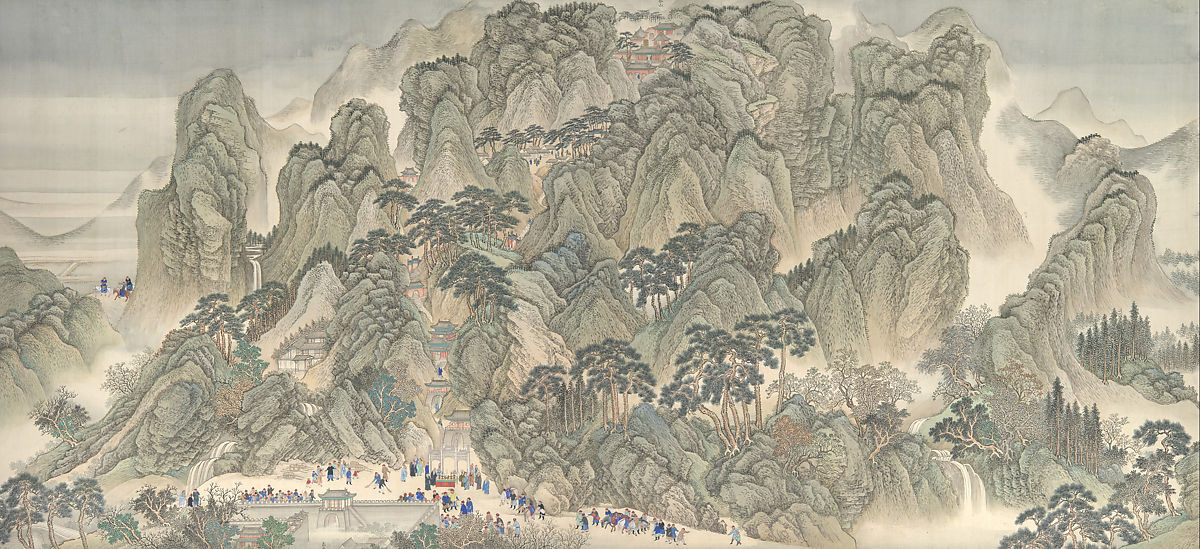
More than three centuries ago, Wang Hui, the most eminent painter of his day in China, put brush to paper to create his masterpiece, "10,000 Miles along the Yangzi River" (1699), also known as "Ten Thousand Li up the Yangtze River.". Collector and connoisseur Wan-go H.C. Weng, who gave this fifty-three-foot-long handscroll to the Museum on the occasion of his 100th birthday, discusses its importance.
Wang Jian
Wang Jian (1598-1677) was a master of painting landscapes and one of the Four Wangs, following the standards of the traditionalists yet establishing his style. His grandfather was a collector of the old master painters, and Wang Jian used the images to inspire his work. The Album of Eighteen Leaves (10.2.3) was a set of paintings made in ink and color on paper; the images for each leaf were based on the work of eight past masters. The image demonstrates his proficiency with brushstrokes to create inspiring mountains.

Wang Shimin
Wang Shimin (1592-1680), the oldest of the Four Wangs, spent much of his life studying the work of Huang Gongwang, a painter from the fourteenth century. He developed a method of painting rocks and filling them with textual brushstrokes of straight lines and horizontal dots. On the hanging scroll (10.2.4), Wang creates mountains that appear to be rising or falling; movement flows across the painting representing nature's continual change.
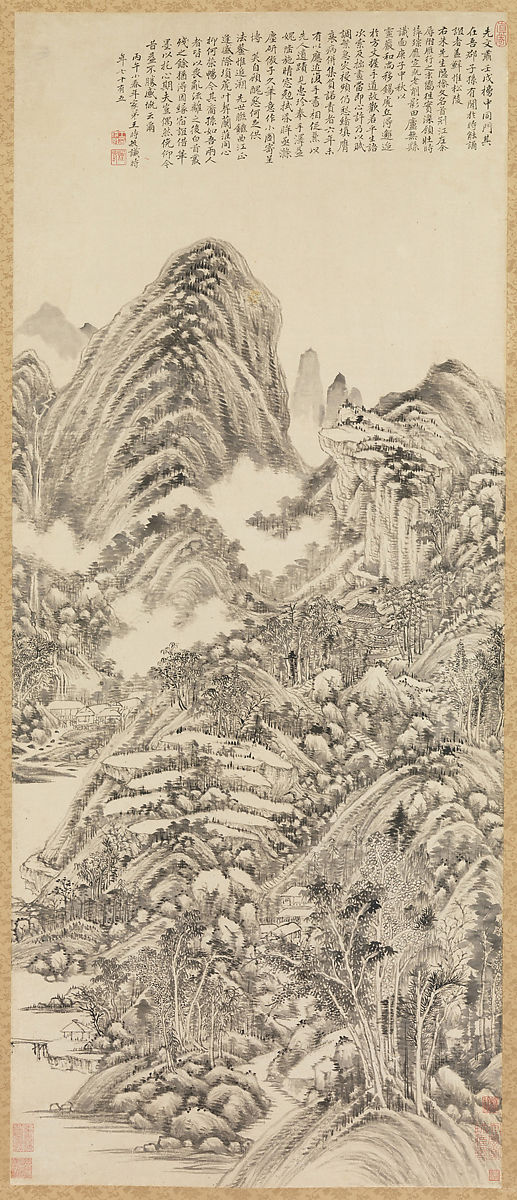
Wang Shimin, Cloud Capped Mountains and Misty Riverside, 1658 (Qing dynasty), hanging scroll, China (Shanghai Museum, China)
Wang Yuanqi
Wang Yuanqi (1642-1715) was a scholar working in the civil service, becoming an artist and painter for the emperor. One of the famous gardens from ancient China was the Wangchuan Villa, inhabited by poets and painters, all drawing inspiration from the picturesque site. Wang Wei was an early poet who wrote elegantly from the villa and inspired Wang Yuanqi to capture Wei's writing in a painting. Wang Yuanqi used the concept of dragon veins, the unseen lines that come from the sky, down the mountains, and along the ground, a type of life force. The brushstrokes in his painted scroll of the villa (10.2.5) follow the concepts of the breath force of life, the rocks flowing and turning, resembling waves of water.

The Individualists
The individualists created art, not following the rigidly defined painting methods and beauty of the orthodox painters like the Four Wangs or the old masters. They tried new techniques and innovations with different types of brushstrokes, washes, colors, and the use of white space. Their paintings were considered irreverent and an insult to the worship of historical styles.
Bada Shanren
Bada Shanren (1626-1705) was a prince's descendant in the Ming dynasty and was considered a childhood prodigy as an artist and poet. When the Ming dynasty fell, he became a monk, eventually leaving because of erratic actions and psychotic episodes, at times refusing to talk. As an artist, he generally used one ink color and a sketching style with short brushstrokes. Even his subject matter was unusual; the scroll (10.2.6) of ink on paper portrayed eagles, heroic symbols of strength from the previous Ming court. The short, forceful brushstrokes form the fierce birds as though watching the new dynasty from afar. The small, quick strokes also give the illusion of the rocks and branches.

In Two Birds (10.2.7), ink and wash scroll goose down feather washes the bodies of the birds, and sharp dark ink is used for the beaks and legs. Shanren inks the tree and the mountain top similarly, making the essential parts in dark ink. He frequently painted birds and flowers in his work. The birds stand on skinny legs, appearing to be precariously perched.

Bada Shanren 八大山人 (朱耷), Lotus and Ducks (colophon by Wu Changshuo 吳昌碩), c. 1696 (Qing dynasty), ink on paper (hanging scroll), image 185 x 95.8 cm (Freer Gallery of Art and Arthur M. Sackler Gallery, Smithsonian Institution).
Shitao (Zhu Ruoji)
Shitao (Zhu Ruoji) (ca. 1642-1707) was also a member of Ming royalty and escaped the invaders by becoming a monk, later becoming one of the well-known individualist artists. He was born in Guangxi province and was part of the Ming dynasty royal household. After the fall of the dynasty, he became a Buddhist and then a Daoist. Shitao became an individualist painter in the early part of the Qing dynasty; his art was considered revolutionary. He used bold brushstrokes, washes, and negative space to depict distance. The grotto and living spaces for an early Daoist patriarch were frequent subject matter for artists. The Grotto (10.2.8) by Shitao is considered his top masterpiece. Using layers of color, blue, green, and salmon, he painted the grotto and surrounding hills with broad brushstrokes. Employing washes of white, he defined the open space in the sky and the opening to the grotto, making them quieter and unknown spaces in the moving landscape.

Curator Joseph Scheier-Dolberg on "Returning Home" by Shitao (Zhu Ruoji).
Gong Xian
Gong Xian (1618-1689) was a painter during the late Ming dynasty and continued painting in the Qing dynasty after the fall of the Ming. As the Ming dynasty collapsed, he went into exile for several years before returning as a professional painter and a master at the Nanjing School. He was considered a master painter who created multiple pieces of art, yet he died in poverty. Eight Views of a Landscape (10.2.9) was considered one of his better works. The painting is made with layers of ink, where he applies a layer of ink, lets it dry, and then adds another layer. He could obtain deep, dark areas that did not look like a wash, the brushstrokes quite evident. No human is in the painting, which is unusual for a Chinese painting. The rocks along the river are well-defined.
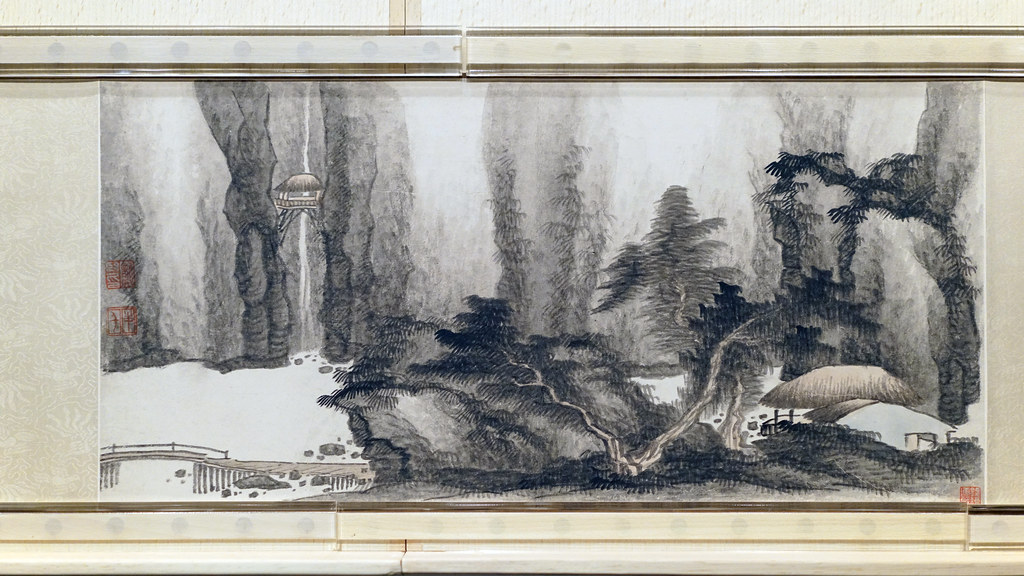
Gong Xian, Eight Views of Landscape, 1684, Qing Dynasty, handscroll, ink on paper (Shanghai Museum).
Porcelain
Pottery has always been an important part of Chinese culture and artistry. During the Ming dynasty, the advanced ceramic centers at Jingdezhen produced beautiful porcelain that is still treasured today. However, the production centers and kilns were destroyed when the Manchu invaded the area and started the Qing dynasty. Fortunately, the factories were rebuilt under the Kangxi emperor, who supported the arts. The Ming techniques were improved, especially the ability to fire at high temperatures and produce a better finish. The ceramic industry flourished and created some of China's most noteworthy porcelains. The Qing ceramists developed new colors and different kinds of enamel pigments, including the highly prized pink color. Workshops were established in multiple locations to manufacture objects made of enamel, jade, ivory, or lacquerware. The established workshops allowed the court to control what was created and how a process remained in place for the entirety of the dynasty.
The Ming Dynasty porcelain jars (10.2.10) and vase (10.2.11) were slightly duller than the Qing porcelain. During the Ming era, the porcelain was fired at a lower temperature, and the white color was not as bright. They also generally used two colors to please the European market. The Qing porcelain plate (x.x) and bowl (x.x) are shinier; the glossy finish resulted from higher firing temperatures than the Ming used. In the Qing era, a wider variety of colors was used, and white was brighter. The Qing also developed better ways to transport the porcelains on the rivers, expanding the market.

Wucai, or five colors, became the preferred color scheme, using underglaze to create the general design and overglazing with enamels of yellow, red, green, purple, and blue on the fired base. Another technical improvement was the development of a new and softer color enamel known as fencai. The artists could blend different tints of color to produce multiple shades or hues. With the opportunity to create a variety of colors, the scenes on the ceramics were more complex with floral and landscape themes. Later, many porcelains were grouped or named by color palettes based on the French term 'famille' groups, such as verte (green) or noire (black). The porcelain was highly prized in the European marketplace, and a significant amount was made for export.
The famille verte plate (10.2.12) demonstrates the detailed design using flowers and birds. The dominant color on the plate is green, so it is classified in the verte or green family. Different shades of green with accents of iron-red overglaze form most of the design. The famille rose plate (10.2.13) depicts a common theme of children and a woman with different household items scattered about. The significant shades on the plate use pinks or roses and other overglaze enamels.

Figure \(\PageIndex{12}\): Famille verte plate
(1662-1722, porcelain) (Public Domain)

Figure \(\PageIndex{13}\): Famille rose plate
(mid-18th century, porcelain with overglaze
polychrome enamels and gold, 3.5 x 21.3 cm)
The porcelain vase (10.2.14) has an opening resembling a garlic bulb on the elongated neck and a rounded body. The bright, colorful painting portrays a woman sitting on a rock next to a bowl of pomegranates, symbolizing fertility. "One of the boys holds a branch of Osmanthus. The Chinese name for Osmanthus is a homophone for "noble." As the plant blooms during the same month as the imperial examinations in the fall, it also signifies literary success. These two concepts reveal that the painting symbolizes the wish to bear high-ranking sons. The two-sentence poem sets an autumnal mood: 'The infinite moon is born in the branches/When blossoms are at their fullest, autumn naturally has come.'"[3] Like most ceramics, the vase was made and fired in pottery workshops and sent to Beijing or another city to be decorated. The figures are finely drawn, and the images of the figures and shrubs expose the Chinese knowledge of European painting methods. The ceramics were also marked on the bottom to indicate the owner or use.

Architecture
Summer Palace
The Summer Palace in Beijing was part of the imperial garden, covering 2.9 square kilometers; only a quarter of the space was land. The space has over 3,000 buildings and "artificial features such as pavilions, halls, palaces, temples, and bridges to form a harmonious ensemble of outstanding aesthetic value."[4] Initially commissioned by the Qing emperor in the late 1700s, the site was used for multiple functions, including administrative, residential, spiritual, and recreational. In the 1850s, the site was highly damaged by fighting in the Second Opium War and then reconstructed. A layout (10.2.15) for the Summer Palace, as it appeared in 1888, was made with pen, ink, and watercolor, demonstrating the vast expanse of the site. The map shows the temples, villages, bridges, soldiers' barracks, gardens, and natural elements of lakes and mountains.
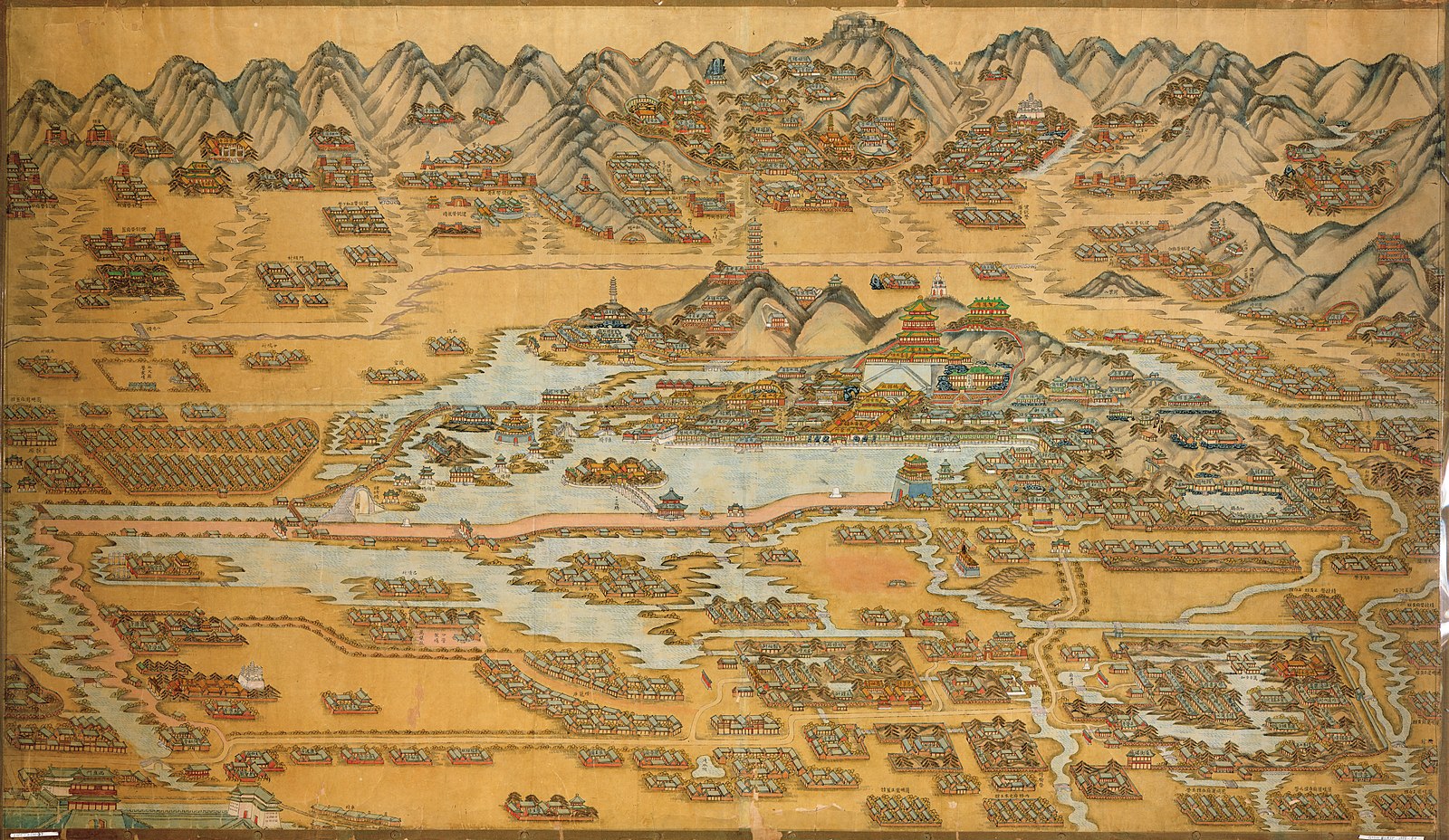
Longevity Hill (10.2.16) is one of the more prominent landmarks where several temples were built to celebrate the empress dowager's birthday. The hill is divided into the area in front of the hill, the rear area, and the area with scattered buildings. The hill is sixty meters high with multiple halls, pavilions, and temples facing the lake in the front and most populated area. The land is more natural on the back or rear of the hill. The hill is adjunct to Kunming Lake (10.2.17), another major part of the area. The lake is man-made, and the dirt from the excavated lake site created Longevity Hill. The Tower of Buddhist Incense (10.2.18) is the grandest building, with three stories and a four-tier roof. The tower was constructed with pear wood, a material of cultural value. Inside the tower is a bronze and gold gilded statue of the Thousand-hand Bodhisattva. The tower is positioned to present a panoramic view of the area.

There are about thirty bridges at the Summer Palace; however, the Seventeen-Arch Bridge (10.2.19) is the longest at a length of 150 meters. Standing on the bridge gives the viewers a stunning look at the Summer Palace. The bridge is made of white marble walls with 544 lions on the columns. Each lion is different in appearance and based on Chinese legends. "Rumor has it that the bridge is set in willows and undulating waves of windy springs, which makes the bridge appear to sway like a pearl necklace."[4]
The Long Corridor (10.2.20) was constructed in the mid-1700s and is 728 meters long. The emperor wanted a walkway for his mother to walk in the gardens, safe from the sun's heat or rainy weather. The walkway runs along Kunming Lake, past Longevity Hill, and around the Cloud-Dispelling Hall. Four octagonal pavilions are located along the corridor, each symbolizing a season. The entire length of the Long Corridor is covered with over 14,000 paintings on the beams and ceiling. The paintings illustrated Chinese classical writings, folk tales, images of well-known figures, and nature's representations of flowers, birds, fish, and insects. One of the paintings is entitled The Seven Sages in the Bamboo Woods (10.2.21). The sages were known in the third century and, at the time, could not achieve their ambitions. They did not look for wealth or fame; instead, they sat among the bamboo with each other, wrote poetry, ate food, and played music and games.


The Summer Palace in Beijing -- first built in 1750, largely destroyed in the war of 1860 and restored on its original foundations in 1886 -- is a masterpiece of Chinese landscape garden design. The natural landscape of hills and open water is combined with artificial features such as pavilions, halls, palaces, temples and bridges to form a harmonious ensemble of outstanding aesthetic value.
Jing'an Temple – 'Temple of Peace and Tranquility'
Jing'an Temple – 'Temple of Peace and Tranquility' was initially started in 247 CE and relocated during the Song Dynasty in 1216. The temple (10.2.22), which still stands in Shanghai, was constructed during the Qing Dynasty. Today, it remains a temple; however, during the Cultural Revolution in China, the facility was used as a plastic factory. A pavilion on each side encloses the temple's central courtyard, the main hall, and, in front, the entrance hall. The golden pagoda tower (10.2.23) is constructed in a small courtyard behind the main hall. The pagoda sits on a seven-story square base, following the traditional odd number of floors. Each floor has decorative eaves overhanging the wall. On top is a decorative finial serving as a lightning rod or what some call the 'demon-arrester.'
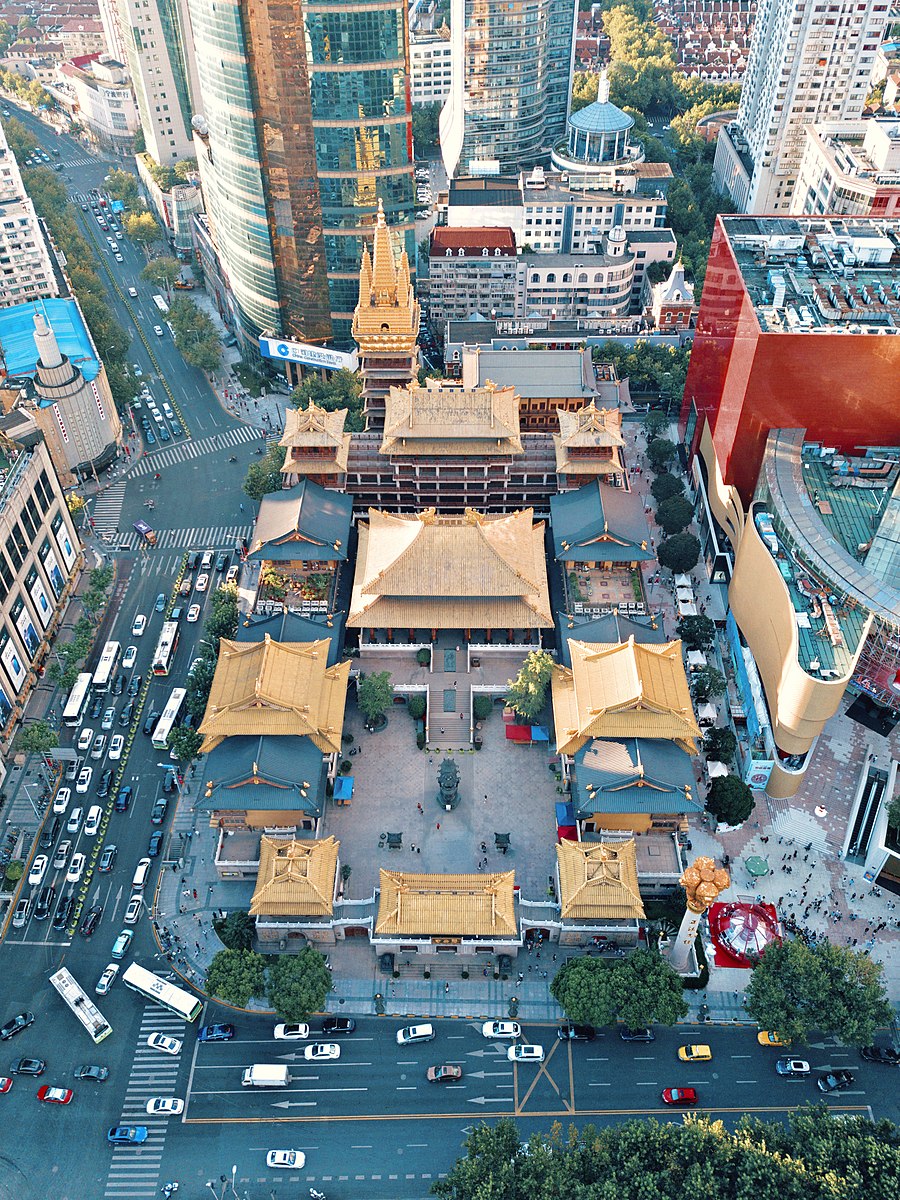
.jpg?revision=1)
The main hall is devoted to one of China's largest seated Buddha statues (10.2.24), weighing about 11,000 kilograms. Also visible is the exquisite woodwork; wood was a common building material as part of the Five Elements Theory, auspicious, representing spring and life. Wood was also easy to use and withstood natural disasters like earthquakes and typhoons. Wood also had repairable parts. The structures in the halls were made with immense teak pillars and carved beams. One of the beams (10.2.25) on the right side remains unfinished, the top of the beam resembling an elephant on one side and a lingzhi mushroom on the other. The unique support system is based on wooden joints set in columns. Sets of brackets were carved and inserted into another carved interlocking piece, allowing multiple stacked brackets.
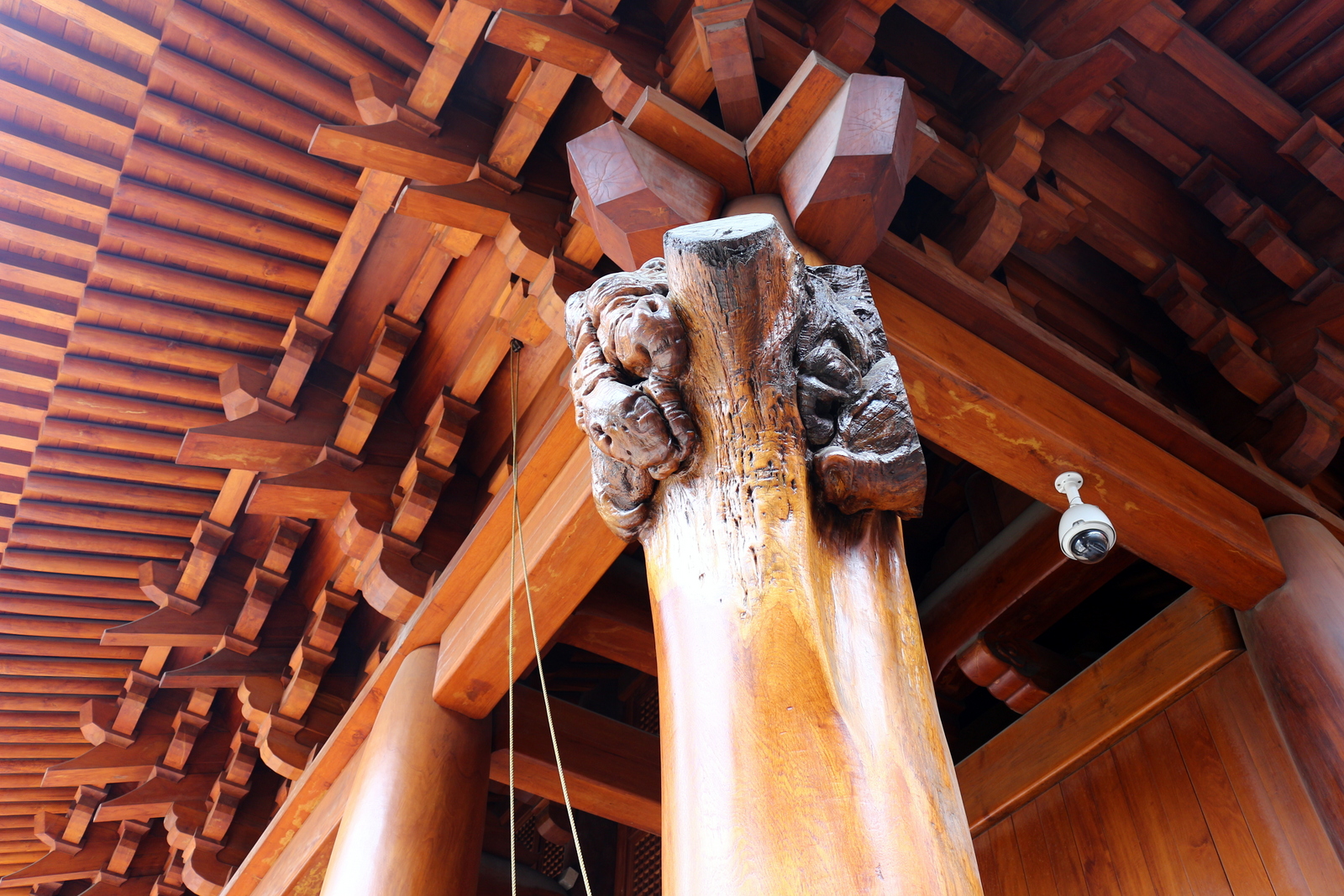
Putuo Zongcheng Temple
Putuo Zongcheng Temple is one of the Eight Outer Temples in Hebei Province, built by the Qianlong Emperor. The emperor constructed buildings at different sites throughout the eastern and northern mountainous areas to strengthen his hold on the outlying ethnic minority regions. The Putuo Zongsheng Temple is the largest palace-garden-temple complex in China. Escaping from the heat of Beijing, the emperors of the dynasty held meetings with different governmental agencies from the outer territories in the summer and autumn. All temples and halls at various sites were carefully and harmoniously integrated into the environment. The gardens at each site became a model for landscape design worldwide.
The emperor wanted the Putuo Zongcheng Temple (10.2.26) constructed for his 60th and his mother's 80th birthday. The sanctuary of the Dalai Lama in Tibet was the model for the temple and is a mix of Tibetan and Chinese styles. Some of the adjacent halls and pavilions by the temples have gold and copper tiled roofs. The temple is one of China's largest complexes, covering 220,000 square meters. The Great Red Platform at the top is made from blocks and painted red, giving the fortress an insurmountable look. The building is made of five and seven stories. Inside the three tiers of each pavilion are forty-four rooms.
Wanfa Guiyi Hall (10.2.27) sits in the courtyard, surrounded by the four walls of the fortress. The roof was aligned with the mountain peak and had gold-plated copper tiles similar to Tibetan architecture. The hall was built with typical Chinese timber and frame construction. The Qianlong emperor consecrated the hall with an audience of Mongol princes. When the Qianlong emperor stood on the red wall, he would have a view of the region and all the temples built in his reign. "In the emperor's eyes, this panoramic view may have appeared to manifest his overarching political aim: to unite different (Manchus, Mongols, Tibetans, and Chinese) in peace and harmony through a common Buddhist belief."[6] Pilgrims from the outer territories came to pray. The building gets little sunshine because of the surrounding walls, creating a solemn environment.


Five Pagoda Gateway (10.2.28) faced south and was constructed in 1768 behind the front gate on the way up to the main hall. "According to Buddhist scripture, Buddhist monks and devotees should pass through the gateway at least twice a day to show their respect for and devotion to Buddha."[7] However, the construction of the gate became more ornamental than serviceable. The entrances were through the gateway, which had three arched doors of the gray-colored walls. On top of the wall, five pagodas were made from brightly colored black, white, yellow, green, and red glazed bricks, each color signifying a religious sect. Two large stone lions guard the entrance. The Tiled Gateway (10.2.29) sits behind the Five Pagoda Gateway and is covered in glazed tiles. A single set of stairs leads to three archways open for passage. On the top of the wall are elaborate roof structures and decorations. Two immense stone lions guard the gates.


[1] Hearn, Maxwell K. "The Qing Dynasty (1644–1911): The Traditionalists." In Heilbrunn Timeline of Art History. New York: The Metropolitan Museum of Art, 2000.
[2] The Qing Dynasty (1644–1911): Painting
[3] Vase of bottle shape with “garlic” mouth
[5] Legend:The Seventeen-Arch Bridge
[6] Temple Eternal Dharma The Wanfa Guiyi Hall in the Post Qianlong Era of the Qing Dynasty
[7] Five-Pagoda Gateway at Putuozongcheng Temple in Chengde of Hebei Province


